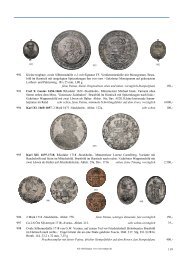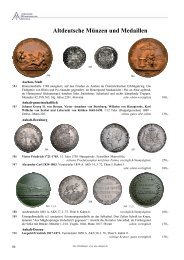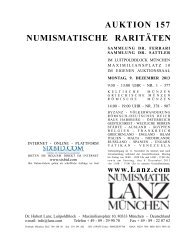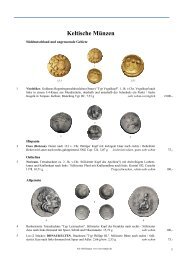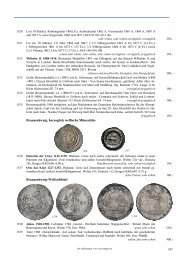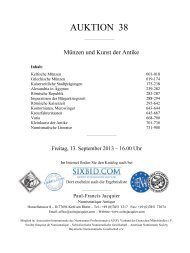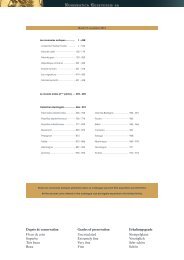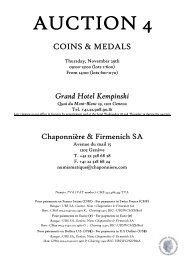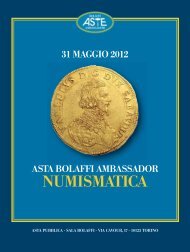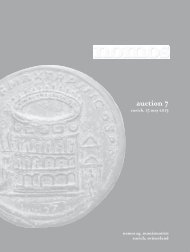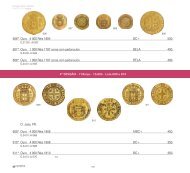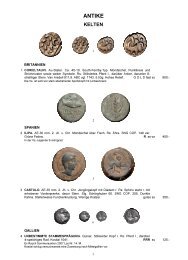AUKTION 156 NUMISMATISCHE RARITÄTEN
AUKTION 156 NUMISMATISCHE RARITÄTEN
AUKTION 156 NUMISMATISCHE RARITÄTEN
Erfolgreiche ePaper selbst erstellen
Machen Sie aus Ihren PDF Publikationen ein blätterbares Flipbook mit unserer einzigartigen Google optimierten e-Paper Software.
43<br />
176 Tetradrachme. Kopf des Philhetairos mit Lorbeerkranz<br />
nach rechts. Rs: ΦIΛETAIPOY. Athena auf einem steinernen<br />
Sitz mit Löwenfüssen nach links sitzend, mit der ausgestreckten<br />
Rechten Kranz haltend, den linken Ellbogen auf am Boden stehenden<br />
Schild gestützt, hinter ihr Bogen und Speer, im inneren<br />
Feld Eule, links außen Biene. Westermark, Taf. 12, V.CXVI-<br />
R.1. 16,99g. Selten. Fast vorzüglich/vorzüglich. 2500,-<br />
1,5:1<br />
EUMENES II. (197 - 158)<br />
177 Tetradrachme, nach 189 v. Chr. Drapierte Büste des Königs<br />
mit Diadem nach rechts, um den Hals die Chlamys (Reitermantel)<br />
geschlungen. Rs: ΒAΣIΛEΩΣ - EYMENOY. Die<br />
beiden Dioskuren, nackt bis auf die Chlamys, nebeneinander in<br />
Vorderansicht stehend, über ihren lorbeerbekränzten Piloi jeweils<br />
ein Stern. Der Linke hält seine Lanze mit der Linken und<br />
legt die Rechte über die Brust, der Rechte trägt in der Linken<br />
ein Kurzschwert und hat mit der Rechten die Lanze gefasst, im<br />
Feld links Thyrsosstab, im Abschnitt A P, das Ganze im Lorbeerkranz.<br />
SNG France 5, 1627 (ex Leu, Auktion 33, 3. Mai<br />
1983, Lot 364), stempelgleich mit diesem Exemplar; BMC 47<br />
(var., Münzmeisterzeichen ΔΙΛ). U. Westermark, The portrait<br />
coins of Eumenes II of Pergamon, in: LAGOM, Festschr. P.<br />
Berghaus (1981), 19-23 mit umfassender Literatur. Drittes bekanntes<br />
Exemplar. 16,74g. Sehr selten. Herrliches, ausdruckstarkes<br />
Portrait, vorzüglich 30000,-<br />
A key to the understanding of this extremely rare and surprising coin is the fact<br />
that the dynasty of Pergamon has never put the portrait of a living ruler on its<br />
coins. So we have to conclude that Eumenes II, when this coin was minted,<br />
was dead or seemed to be dead. Therefore it is highly probable that Eumenes’<br />
brother Attalos had this coin issued after the attempt against Eumenes’ life in<br />
172 BC, when the whole world, including his brother, believed that he was<br />
dead. In this for Pergamon so critical situation Attalos took over both, the rule<br />
and Eumenes’ wife, and minted a coin with the portrait of his putatively dead<br />
brother on the obverse and the Dioscuri with their star-crowned caps (piloi) on<br />
the reverse. By means of this coin Attalos could propagate his brotherly love<br />
(philadelpheia) and his legitimacy. The Dioscuri could be understood as the<br />
personification of the two royal brothers’ mutual love as well as tutelary divinities<br />
of his kingdom. As it results from the two up to now known pieces,<br />
showing two different mint marks, there must have been at least two issues of<br />
this coin, so that a first view it is surprising that only very few examples of it<br />
have survived. The explanation for this is obvious. When it came to light that<br />
Eumenes was seriously injured, but still alive, Attalos had to withdraw this<br />
coin type, to that it became one of the rarest coins of the Ancient World.<br />
176<br />
1,5:1<br />
177<br />
1,5:1



